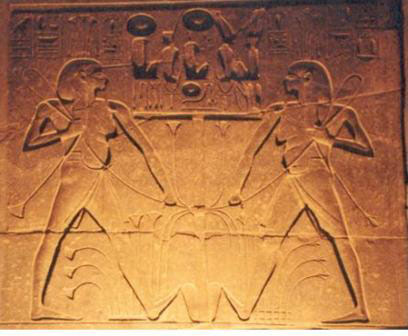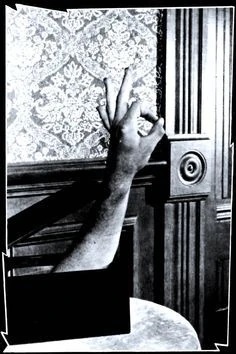-
Content count
3,167 -
Joined
-
Last visited
-
Days Won
10
Posts posted by Mark Foote
-
-
On 12/19/2024 at 2:34 AM, Apech said:The magic staff:
-
A deeply respected teacher, Joshu Roshi has not been without controversy over his many years of teaching—there have been allegations of improprieties with students. However, this never gave rise to the institutional shakeups that occurred in other founding Zen centers.
("Zen Master Who?", James Ishmael Ford, p 112)
“My hand just moves. It’s will-less (ishinashini).”
(Joshu Sasaki, quoted in "Some Reflections On Rinzai-Ji", by Giko David Rubin) -
Nothing to do?
Nothing to do?
Put some mustard in your shoe,
Fill your pockets full of soot,
Drive a nail into your foot,
Put some sugar in your hair,
Place your toys upon the stair,
Smear some jelly on the latch,
Eat some mud and strike a match,
Draw a picture on the wall,
Roll some marbles down the hall,
Pour some ink in daddy’s cap —
Now go upstairs and take a nap.
--Shel Silverstein-
 2
2
-
 1
1
-
-
2 hours ago, Taomeow said:
Tragedy upon tragedy. Salmon is apparently dangerous! I already knew they named it after salmonella, but I had no idea there's other perils hiding in that fish!
Salmon is apparently dangerous! I already knew they named it after salmonella, but I had no idea there's other perils hiding in that fish!
Speaking of dangerous foods:
Once upon a time I had a summertime romance. He was working during the day while I was on vacation, and I spent my daytime hours foraging for wild mushrooms which were abundant in that location. On my last vacation day I cooked a large skillet of the choicest, chiefly boletus mushrooms, and brought it to the farewell party he and his friends were throwing for me. He was taking pictures of me the whole time while the romance was going on, dozens of them, and was supposed to mail them to me once processed (that was the era before smartphones, photos were physical.) I never got any mail and never heard from him again. Which left me with a lifelong unanswered question:
did he just decide that what happens during the summer stays in the summer, or
did I kill him and/or some of/all of his friends by inadvertently letting a death cap slip into my mushroom harvest?
Clever way to take care of those compromising photos, Taomeow. Maybe you slipped in an amanita, and he went flying with the reindeer...-
 1
1
-
-
-
On 12/16/2024 at 7:23 PM, stirling said:Daniel will not be darkening our doors. He internet/board stalked me when he took exception to me for reasons unknown, peppering every thread I was posting on with twisted personal history, mischaracterization, out and out fabrication. When I asked the last group of admins for help they volunteered to take action, but I asked them to be lenient, hoping he might be kinder and gentler. I just wanted it to stop. He then got into an insulting and angry altercation with Dwai and was banned for a few weeks. At the time he could have been banned permanently, but we decided against it. Daniel had plenty of opportunities to make a different choice, but his anger or whatever is going on got the best of him. This time was his last chance. Yes, it is unfortunate. I felt he had some interesting perspective to offer, but it was always HIS choice to make.
No-one doing admin here is being paid - it isn't a road to fame or fortune. I think of it as a way to give back here for this fantastic resource we are afforded. Doing the job without being personally abused doesn't seem unreasonable does it? Who would do it under such conditions? I wouldn't.
He was pretty clear that he didn't respect authority based on transmission. Can you blame him!
I don't either. I've sat with a few Soto Zen teachers who didn't know what they were talking about. No-one can possibly transmit what actually matters. Authority comes from prajna paramita. Daniels problem wasn't with authority, it was with anything do with non-duality... ironic on a Daoist bulletin board, but...
Thanks, Stirling (do you prefer small "s", or were you typing fast...). I was fishing for that explanation, of course. Reprehensible, that he was trolling you. Interesting that he mentioned having students of his own, presumably with regard to Judaism?
I do appreciate the admins, and more so for hearing the allowance that was given to Daniel.
Writing a piece now about what is transmitted, when transmission is claimed. I did quote some of it. I agree with you and Dwai (& ol'3bob too), that it's a real thing, that there are teachers who tap into something and convey something, yet the thing that we all bring to Dao Bums is a profound desire to be able to repeat the experiment. To find the thought initial and sustained that, together with "the essential place", trip us over the light fantastic to drop body and mind in one sitting, or on demand.
I'll have the Bacon McDouble (it's for the cat)!
-
 2
2
-
 1
1
-
-
Is Daniel ex-communicated, for the nonce?
T'was not so much the topic, as Daniel that I was concerned with losing.He was pretty clear that he didn't respect authority based on transmission. Can you blame him! From a post I'm working on for my own site:
Gautama refused to name a successor (DN 16, PTS vol. ii p 107). His advice was to go by the words of the teacher rather than any claim to authority, to compare the instructions of a teacher to the sermons Gautama himself had given and to the rules of the order that Gautama himself had laid down (DN 16 PTS vol. ii pp 133-136).
At the same time, activity solely by virtue of the free location of consciousness, the sign of the fourth concentration, has been conveyed by demonstration in some branches of Buddhism for millennia. The transmission of a central part of the teaching through such conveyance, and the certification of that transmission by the presiding teacher, is regarded by some schools as the only guarantee of the authenticity of a teacher.
In the days before his demise, Gautama gave one final piece of advice to his followers on who to trust:
Look not for refuge to any one besides yourselves. And how… is (one) to be a lamp unto (oneself), a refuge unto (oneself), betaking (oneself) to no external refuge, holding fast to the Truth as a lamp, holding fast as a refuge to the Truth, looking not for refuge to any one besides (oneself)?
Herein, … (one) continues, as to the body, so to look upon the body that (one) remains strenuous, self-possessed, and mindful, having overcome both the hankering and the dejection common in the world. [And in the same way] as to feelings… mind… mental states, (one) continues so to look upon each that (one) remains strenuous, self-possessed, and mindful, having overcome both the hankering and the dejection common in the world.
(DN 16; tr. PTS Vol II p 108; Horner’s “body, feelings, mind, and mental states” substituted for Rhys Davids’ “body, feelings, moods, and ideas”)Like the man said:
When you arrive at last at towering up like a wall miles high, you will finally know that there aren’t so many things.
(“Zen Letters: the Teachings of Yuanwu”, tr. Thomas Cleary, p 83)
-
 2
2
-
-
A topic was closed by a moderator, no doubt because the discussion turned into a personal exchange.
I'd like to suggest that one of the parties could have left the discussion, at least temporarily. There are things that warrant serious further consideration, on both sides, but the poster did request that the party he had issues with leave the discussion and instead of that, the topic was closed. How does that help the poster to make use of the forum? We are here to learn, as was the poster.Ok, off my soap box. Just didn't think it should pass without comment.
Looks like the topic has been restarted... hmmm.
Appears that the individual whose post was "closed to further replies" has now been banned from the forum.
There's a weight on you
But you can't feel it
Livin' like I do
It's hard for you to see itWas I hurt too bad
Can I show you daylight
How could I be sad
When I know that you mightLook out for my love, look out for my love
Look out for my love, look out for my loveLook out for my love
It's in your neighborhood
I know things are gonna change
But I can't say bad or good
(Neil Young, "Look Out for My Love")-
 2
2
-
-
3 hours ago, Daniel said:Being down to earth.

... is lacking transcendence.
"What is transcending transcendence?" requires transcendence. That's what makes this question difficult.
The daughter's response is transcending transcendence--it's also "being down to earth":
Layman Pang was with his whole family sitting around the fire. Layman Pang suddenly said, ‘Difficult, difficult—ten bushels of oil hemp spread out on a tree.’ Mrs. Pang said, ‘Easy, easy—on the tips of the hundred grasses, the meaning of Zen.’ Their daughter Lingzhao said, ‘Not difficult, not easy—eating when hungry, sleeping when tired’.(“Zen Letters: Teachings of Yuanwu”, trans. Cleary & Cleary, pg 41)
However, the Chinese teacher Yuanwu who offered the story went on to say:
Usually when I relate this story to people, most of them prefer Lingzhao’s remark for saving energy, and dislike what Old Man Pang and Old Lady Pang said about difficult and easy. This is nothing but ‘making interpretations by following the words’. People who think like this are far from getting to the root of the fundamental design.
(ibid)
But tell me, what is the most essential place? How is effort applied?
(Yuanwu, “The Blue Cliff Record”, Case 55, tr. Cleary and Cleary)
-
 2
2
-
-
1 hour ago, Maddie said:... it is important to understand that if a trans woman has been on hrt (hormone replacement therapy) for approximately two years then her hormone levels and therefore muscular strength are the same as any other cis woman's on average...
Can you quote a source on that? I'd love to be able to cite it, with friends. -
On 12/7/2024 at 5:35 PM, Turnip said:I am in my early twenties and have not dug deep enough in any direction, partly because I don’t know where the water is. Maybe it’s part of the process.
Does anyone have any words of advice, or experience of their own?
Using a forked branch or two l-shaped rods, a water witch will hold their chosen tool while walking slowly across the land. As they move over the water source, the tool will move, indicating where to dig or drill. Some dowsers can even specify the depth at which to drill.
https://blackflash.ca/expanded/how-to-dowse
I can say that certain things stand out for me, with regard to moving from the source. From my own writing:
The presence of mind can utilize the location of attention to maintain the balance of the body and coordinate activity in the movement of breath, without a particularly conscious effort to do so. There can also come a moment when the movement of breath necessitates the placement of attention at a certain location in the body, or at a series of locations, with the ability to remain awake as the location of attention shifts retained through the exercise of presence.
If I can find a way to experience gravity in the placement of attention as the source of activity in my posture, and particular ligaments as the source of the reciprocity in that activity, then I have an ease.
(Applying the Pali Instructions)The idea here is that the consciousness identified with the self, with “I am”, must be allowed to move freely in the body, while a presence of mind sufficient to retain one-pointedness is mustered up. If the presence is mustered, there’s a feeling of ease connected with one-pointedness, and a sense of gravity (“towering up like a mile-high wall”, as Yuanwu used to say) that allows the automatic activity of the body to proceed solely by virtue of one-pointedness (and the location of one-pointedness).
(My Advice)
My advice would be to look for consciousness to move away from the head in the moments before falling asleep, then allow for that same freedom of movement in seated meditation.
(from a pending post on my own site)
My abbreviation of Gautama's "four arisings of mindfulness":
1) Relax the activity of the body in inhalation and exhalation;
2) Find a feeling of ease and calm the senses connected with balance, in inhalation and exhalation;
3) Appreciate and detach from thought, in inhalation and exhalation;
4) Look to the free location of consciousness for the automatic activity of inhalation and exhalation.
Bear in mind:But usually in counting breathing or following breathing, you feel as if you are doing something, you know– you are following breathing, and you are counting breathing. This is, you know, why counting breathing or following breathing practice is, you know, for us it is some preparation– preparatory practice for shikantaza because for most people it is rather difficult to sit, you know, just to sit.
(“The Background of Shikantaza”, Shunryu Suzuki; San Francisco, February 22, 1970)-
 1
1
-
-
6 hours ago, Taomeow said:That's exactly (well, almost exactly) what's happening here now, chiefly in New Jersey but they're being spotted elsewhere too (including here in CA, close to my neck-of-the-woods). Massive unidentified crepuscular drone activity and no one knows what they are, but the Pentagon made an official statement yesterday asserting they know what they aren't. They aren't our military, they aren't another country's, they aren't amateur hobbyists'. End of story.
The drones, per hundreds of nightly eyewitnesses, are huge -- the smallest ones are the size of an SUV, and a journalist (who is also president of some birdwatching club and is always looking up) described the one he saw over Montclair, NJ as the size of a two-car garage or a school bus or something on that scale. Whether Jesus is involved is debatable, but according to the Pentagon which pretty much excluded all other possibilities (except maybe one more -- which I personally think might be the closest to the truth), in the absence of another explanation, the Jesus factor might be as feasible as any other.
Nothing to see here, folks, move along.
-
 1
1
-
-
-
17 hours ago, Gerard said:One more thing, which I have many times stated on this forum in the past, in case you missed it.
"Dont walk this path alone in the beginning because you won't go far."
In other words, you need a teacher that will guide you in the beginning and help you with the big road blocks you'll encounter m, which will be countless and impossible to manage alone.
The Buddhist Theravada meditation system is very sophisticated and can't be learnt without proper guidance.Look not for refuge to any one besides yourselves. And how… is (one) to be a lamp unto (oneself), a refuge unto (oneself), betaking (oneself) to no external refuge, holding fast to the Truth as a lamp, holding fast as a refuge to the Truth, looking not for refuge to any one besides (oneself)?
Herein, … (one) continues, as to the body, so to look upon the body that (one) remains strenuous, self-possessed, and mindful, having overcome both the hankering and the dejection common in the world. [And in the same way] as to feelings… mind… mental states, (one) continues so to look upon each that (one) remains strenuous, self-possessed, and mindful, having overcome both the hankering and the dejection common in the world.
(DN 16; tr. PTS Vol II p 108; Horner’s “body, feelings, mind, and mental states” substituted for Rhys Davids’ “body, feelings, moods, and ideas”) -
On 11/26/2024 at 9:04 PM, Chang dao ling said:
Thanks again. Do you know any reasons why I am getting headache after meditation? I can't sleep well if I meditate more than 20 min
I have no experience with either of those symptoms.
What posture do you meditate in?Something else that I wrote:
In one of his lectures, Shunryu Suzuki spoke about the difference between “preparatory practice” and “shikantaza”, or “just sitting”:
But usually in counting breathing or following breathing, you feel as if you are doing something, you know– you are following breathing, and you are counting breathing. This is, you know, why counting breathing or following breathing practice is, you know, for us it is some preparation– preparatory practice for shikantaza because for most people it is rather difficult to sit, you know, just to sit.
(“The Background of Shikantaza”, Shunryu Suzuki; San Francisco, February 22, 1970)
Suzuki said that directing attention to the movement of breath (“following breathing… counting breathing”) has the feeling of “doing something”, and that “doing something” makes such practice only preparatory.
Although attention can be directed to the movement of breath, necessity in the movement of breath can also direct attention, as I wrote previously:
There can… come a moment when the movement of breath necessitates the placement of attention at a certain location in the body, or at a series of locations, with the ability to remain awake as the location of attention shifts retained through the exercise of presence.
There’s a frailty in the structure of the lower spine, and the movement of breath can place the point of awareness in such a fashion as to engage a mechanism of support for the spine, often in stages.
(Shunryu Suzuki on Shikantaza and the Theravadin Stages)
The idea here is that the consciousness identified with self, with "I am", must be allowed to move freely in the body, while a presence of mind sufficient to retain one-pointedness is mustered up. If the presence is mustered, there's a feeling of ease connected with one-pointedness, and a sense of gravity ("towering up like a mile-high wall", as Yuanwu used to say) that allows the automatic activity of the body to proceed solely by virtue of one-pointedness (and the location of one-pointedness).
If the placement of attention is not through a necessity of breath or posture (or more) that comes in the course of an inhalation or exhalation, then the automatic activity of the body is inhibited. Might even result in a headache, but I'm guessing, as that's not a symptom I've experienced.
Ta-chi said, “How can you produce a mirror by polishing a tile?”
Nan-yueh replied, “How can you make a Buddha by sitting in meditation?”
Ta-chi asked, “Then, what is right?”
Nan-yueh answered, “When a man is driving a cart, if the cart doesn’t go, should he beat the cart or beat the ox?”
(“Dogen’s Manuals of Zen Meditation”, Carl Bielefeldt, p 195-195, UC Press ed. 1988)
To rephrase my earlier advice, keep a presence of mind with the location of consciousness right before you fall asleep, see where the mind goes.
-
 1
1
-
-
8 hours ago, Chang dao ling said:Thank you very much 🙏
You're very welcome. The best of my writing on the subject is here, if you want more details:
I hope to be around, if you have any questions--I'm just trying to teach myself, if you really want to know!
-
 1
1
-
-
-
16 hours ago, Chang dao ling said:QuoteHow do you interpret the fifteenth element, the third in the mindfulness of states of mind (the states of mind being the last of the four arisings of mindfulness)?
Sorry I don't know. Can you elaborate? Do you practice anapanasati?
Yes and yes, although I should say that what I practice is my understanding of the actionable elements of Anapanasati.
Here's the fifteenth element, from F. L. Woodward's translation of the "Chapter on Inbreathing and Outbreathing" of the Samyutta Nikaya volume five:
Contemplating cessation I shall breathe in. Contemplating cessation I shall breathe out.
(SN 54.1; tr. Pali Text Society [PTS] vol. V p 275-276)
The mindfulness recounted in that chapter is exactly the mindfulness recounted in Anapanasati--I prefer Woodward's translation of the elements over Horner's rendition (in PTS MN 118), but the sixteen elements are the same in both places.
There are various cessations mentioned in the sermon volumes. I believe the cessation that was referenced in the fifteenth element was the cessation of the activities:
…I have seen that the ceasing of the activities is gradual. When one has attained the first trance, speech has ceased. When one has attained the second trance, thought initial and sustained has ceased. When one has attained the third trance, zest has ceased. When one has attained the fourth trance, inbreathing and outbreathing have ceased… Both perception and feeling have ceased when one has attained the cessation of perception and feeling.
(SN 36.11; tr. PTS vol IV p 146)
The activities are the habitual or volitive actions of speech, body, and mind. The cessation of inbreathing and outbreathing does not mean that breathing in and breathing out have ceased, only that habit and volition in inbreathing and outbreathing have ceased. Likewise, the cessation of perception and feeling is only the cessation of habit and volition in perception and feeling.
Gautama defined concentration in terms of "one-pointedness of mind":And what… is the (noble) right concentration with the causal associations, with the accompaniments? It is right view, right purpose, right speech, right action, right mode of livelihood, right endeavor, right mindfulness. Whatever one-pointedness of mind is accompanied by these seven components, this… is called the (noble) right concentration with the causal associations and the accompaniments.”
(MN III 117 tr. PTS vol III p 114; “noble” substituted for Ariyan; emphasis added)
This is where Vipassana teachers and some Theravadin teachers will differ from Ch'an and Zen teachers. I'm writing about that now, and I hope you will excuse my inclusion of a lengthy quote from my work-in-progress:
The difficulty is that “one-pointedness of mind” has been taken by different people in the Buddhist community to mean different things. One modern Theravadin teacher, for example, has disputed that the term could actually refer to the mind as a singular point, and instead posits that the reference is to a singular object of attention:
A Pali sutta, MN 44, defines concentration as cittass’ek’aggatā, which is often translated as “one-pointedness of mind”: cittassa = “of the mind” or “of the heart,” eka = one, agga = point, -tā = -ness. MN 117 defines noble right concentration as any one-pointedness of mind supported by the first seven factors of the noble path, from right view through right mindfulness. MN 43 states further that one-pointedness is a factor of the first jhāna, the beginning level of right concentration.
From these passages, it has been argued that if one’s awareness in
concentration or jhāna is truly one-pointed, it should be no larger than a point, which means that it would be incapable of thinking, of hearing sounds, or even of being aware of the physical body. However, this interpretation imposes too narrow a meaning on the word ek’aggatā, one that is foreign to the linguistic usage of the Pali Canon.… (the teacher concludes: ) Show your lack of contempt for your meditation object by giving it your full attention and mastering concentration… Gather the mind around its one object.
(https://www.dhammatalks.org/Archive/Writings/CrossIndexed/Uncollected/MiscEssays/OnePointed160822.pdf, Thanissaro Bhikkyu; parenthetical added)
In my experience, “one-pointedness” has more to do with the self as a singular entity than with single-minded attention to a meditation object.
A teacher in modern India, Nisargadatta, described the self as “the consciousness in the body”:
You are not your body, but you are the consciousness in the body, because of which you have the awareness of “I am”. It is without words, just pure beingness.
(Gaitonde, Mohan [2017]. Self – Love: The Original Dream [Shri Nisargadatta Maharaj’s Direct Pointers to Reality])For most people, the consciousness associated with “I am” is at one single location at any given moment.
Nisargadatta went on to say:
Meditation means you have to hold consciousness by itself. The consciousness should give attention to itself.(ibid)
Zen teacher Koan Franz talked about the difference between attention to a meditation object, and attention to the base of consciousness, “the mind”:
So (in zazen), have your hands… palms up, thumbs touching, and there’s this common instruction: place your mind here. Different people interpret this differently. Some people will say this means to place your attention here, meaning to keep your attention on your hands. It’s a way of turning the lens to where you are in space so that you’re not looking out here and out here and out here. It’s the positive version, perhaps, of ‘navel gazing’.The other way to understand this is to literally place your mind where your hands are–to relocate mind (let’s not say your mind) to your center of gravity, so that mind is operating from a place other than your brain. Some traditions take this very seriously, this idea of moving your consciousness around the body. I wouldn’t recommend dedicating your life to it, but as an experiment, I recommend trying it, sitting in this posture and trying to feel what it’s like to let your mind, to let the base of your consciousness, move away from your head. One thing you’ll find, or that I have found, at least, is that you can’t will it to happen, because you’re willing it from your head. To the extent that you can do it, it’s an act of letting go–and a fascinating one.
(“No Struggle [Zazen Yojinki, Part 6]”, by Koun Franz, from the “Nyoho Zen” site;
https://nyoho.com/2018/09/15/no-struggle-zazen-yojinki-part-6/)
Franz suggested that “the base of consciousness” can move to a location in the body outside the head, through “an act of letting go”.
Gautama also spoke about letting go, more specifically about “self-surrender”:… making self-surrender the object of thought, (a person) lays hold of concentration, lays hold of one-pointedness.
(SN 48.10, tr. PTS vol. V p 174)
Shunryu Suzuki, founding teacher of the San Francisco Zen Center, spoke about the mind moving in zazen:Sometimes when you think that you are doing zazen with an imperturbable mind, you ignore the body, but it is also necessary to have the opposite understanding at the same time. Your body is practicing zazen in imperturbability while your mind is moving.
(“Whole-Body Zazen”, lecture by Shunryu Suzuki at Tassajara, June 28, 1970; edited by Bill Redican)
Franz described “an act of letting go” to allow “the base of consciousness” to move away from the head. Gautama spoke of “making self-surrender the object of thought” in order to lay hold of “one-pointedness”. Suzuki spoke of the body practicing in imperturbability while the mind is moving.
My advice would be to look for consciousness to move away from the head in the moments before falling asleep, then allow for that same freedom of movement in seated meditation.
Here's my summary of the actionable elements of the mindfulness described in Anapanasati:
1) Relax the activity of the body in inhalation and exhalation;
2) Find a feeling of ease and calm the senses connected with balance, in inhalation and exhalation;
3) Appreciate and detach from thought, in inhalation and exhalation;
4) Look to the free location of consciousness for the automatic activity of inhalation and exhalation.
(Applying the Pali Instructions)
In my experience, once all of the elements above come into awareness, they tend to interchange in a natural way.
I sit down first thing in the morning and last thing at night, and I look to experience the activity of the body solely by virtue of the free location of consciousness. As a matter of daily life, just to touch on such experience as occasion demands—for me, that’s enough.-
 1
1
-
-
13 hours ago, Thrice Daily said:
Together as oneboth Electricity and
Magnetism Guide Us
Magnetism guide us
to da nort' pole, man it cold
pink camellias
-
19 hours ago, Chang dao ling said:
I am practice visualisation meditation due to this I am getting headache. I also tried anapanasati again I am getting headache. So I want to try Vipassana
Sorry to hear that about Anapanasati. How do you interpret the fifteenth element, the third in the mindfulness of states of mind (the states of mind being the last of the four arisings of mindfulness)?
-
 1
1
-
-
21 hours ago, Bindi said:This aligns with a nuanced interpretation of wu wei: it does not mean doing nothing but rather doing what is essential and in alignment with the greater flow.
From a piece I'm currently writing:
Gautama would generally describe a set of four "corporeal" concentrations, and then describe the set of five "incorporeal" concentrations.
“Corporeal” is defined in the Oxford dictionary as “relating to a person's body”. The four corporeal concentrations concern the body in that they culminate in a cessation of habit and volition in the activity of the body. In particular, they culminate in a cessation of habit and volition in the activity of inhalation and exhalation.
About the five “incorporeal" concentrations, Gautama said very little. My understanding is that they have to do with the experience of things that are beyond the range of the senses. According to Gautama, the “incorporeal” concentrations culminate in a cessation of habit and volition in the activity of the mind, in particular a cessation of habit and volition in the activity of feeling and perceiving.
The cessation of habit and volition in speech, deed, and mind, is not the cessation of speech, deed, and thought. I think it does match the description "wu-wei", however--doing nothing yet everything is done.
I've spent my life since age 25 attempting to reconcile the experience of action of the body without habit or volition with the demands of everyday life for the exercise of habit and volition. That would seem to be the issue you are addressing, in your conclusion about the interpretation of wu-wei.What I discover is that the mindfulness that Gautama referred to as his way of living only requires a return to the cessation of habit and volition in the activity of the body, as appropriate:
Gautama often referred to the four “corporeal” concentrations, together with an overview of the body taken after the fourth, as “the five limbs” of concentration. My guess is that he generally practiced “the five limbs”, and only occasionally took up the "incorporeal" concentrations.
I believe the practice of the five limbs was a necessary part of the mindfulness that was Gautama’s way of living.Gautama described his way of living as a mindfulness of the body, the feelings, the mind, and the mental states, a mindfulness set up through sixteen contemplations, each made with an awareness of breathing in or breathing out (SN 54.12; PTS vol. V p 289). Among the sixteen was the contemplation of “cessation”:
Contemplating cessation I shall breathe in. Contemplating cessation I shall breathe out.(SN 54.1; Pali Text Society vol. V p 275-276)
The contemplation of “cessation” while breathing in and while breathing out is particularly conducive to the cessation of habit and volition in inhalation and exhalation, particularly if there has been a recent experience of “the five limbs”.
I have summarized the actionable elements of Gautama’s mindfulness:
1) Relax the activity of the body in inhalation and exhalation;
2) Find a feeling of ease and calm the senses connected with balance, in inhalation and exhalation;
3) Appreciate and detach from thought, in inhalation and exhalation;
4) Look to the free location of consciousness for the automatic activity of inhalation and exhalation.
In my experience, once the elements above are brought into awareness, they tend to interchange in a natural way.
Gautama declared the mindfulness set up through the sixteen elements to be the “best of ways”, and his usual way of living in the rainy season (SN 54.11; PTS vol. V p 289; see also MN 118).
Hopefully I will post the complete piece on my site soon.
The reconciliation of "wu-wei" with everyday life requires only being able to "wu-wei" with regard to the activity of the body in the appropriate moment, and for most purposes that can be set up in regular seated meditation. Nevertheless, the result is as Shunryu Suzuki said:
So, when you practice zazen, your mind should be concentrated in your breathing and this kind of activity is the fundamental activity of the universal being. If so, how you should use your mind is quite clear. Without this experience, or this practice, it is impossible to attain the absolute freedom.
(“Thursday Morning Lectures”, November 4th 1965, Los Altos; emphasis added)
-
 2
2
-
-
-
8 hours ago, Chang dao ling said:
Hi,How to practice Vipassana meditation? Please recommend me a good teacher and books 🙏
Hope you don't mind my asking, but why Vipassana in particular?
-
 1
1
-
-
3 hours ago, dwai said:
The mind is a mirror in which we see the reflection of our Self -- that's the seeing and recognizing part.The dust of life settles on this mirror gradually and obscures the image. So we clean the mirror every day -- that's the maintaining part.
Is it necessary to keep cleaning the mirror after seeing and recognizing it? The question arises "Who is recognizing, and who is cleaning/maintaining? Who knows if the image is clear or obscure?" That one doesn't (need to) do anything.
In physical terms, activity of the body solely by virtue of the location of consciousness is regulated by the stretch of ligaments and fascia. Ligaments in particular stretch and resile, especially waking and sleeping, and each day the relationship of freedom in the location of consciousness to the stretch of ligaments and the activity of the body changes.
I've written about the fourth jhana:Things can shift from activity of the body coordinated by the free placement of consciousness, to activity that takes place solely by virtue of the free location of consciousness. Here’s Gautama’s description of the fourth concentration:
Again, a (person), putting away ease… enters and abides in the fourth musing; seated, (one) suffuses (one’s) body with purity by the pureness of (one’s) mind so that there is not one particle of the body that is not pervaded with purity by the pureness of (one’s) mind. … just as a (person) might sit with (their) head swathed in a clean cloth; even so (one) sits suffusing (their) body with purity…
(AN III Book of Fives, The Fivefold, The Five-Limbed, Pali Text Society vol. III p 18-19)
... In some sermons, Gautama offered a variation on his metaphor for the fourth concentration:
… it is as if (a person) might be sitting down who had clothed (themselves) including (their) head with a white cloth; there would be no part of (their) whole body that was not covered by the white cloth.
(MN III 119 Pali Text Society vol. III p 134)
In the fourth concentration, ease in the nerve exits between vertebrae along the sacrum and spine provides an ability to feel right to the surface of the skin all over the body, such that “there is not one particle of the body” that cannot receive the placement of consciousness.
(Applying the Pali Instructions)
With regard to the description of the fourth concentration:
Gautama made clear through his choice of words (“not one particle… that is not pervaded”) that the mind can remain one-pointed, even as the body is suffused with “purity by the pureness of mind”.
An evenness in the nerve exits between vertebrae along the sacrum and spine is effected by a freedom of location in the one-pointed consciousness identified with the self in the body. The prior three jhanas involve particular patterns of coordination between the location of consciousness and stretch and resile in the ligaments of the pelvis, sacrum, and spine, patterns of coordination that effect the stretch and resile of ligaments necessary to open the related nerve exits and realize feeling throughout the body.











Haiku Chain
in General Discussion
Posted
divine passion blooms
seasonless awakening
Flower buds shiver
Flower buds shiver
winter suddenly arrives
mountains topped with snow